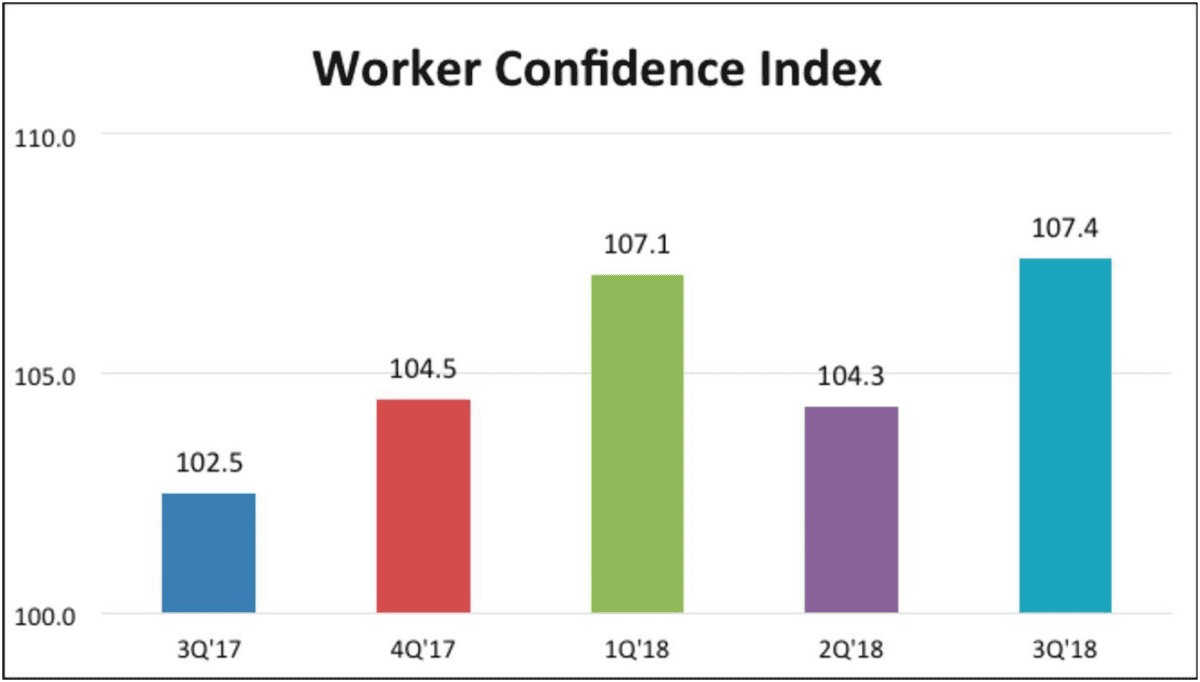Worker confidence remains high despite a volatile market.
By Larry Basinait
The Worker Confidence Index (WCI) for the third quarter of 2018 increased by 3.1 points and, at 107.4, is now at its highest level since the first quarter of 2017. All four indices of worker confidence were on the rise this quarter, with likelihood of promotion jumping the most, up to 113.7. The likelihood of a raise and trust in company leadership indices also increased for the quarter by about 3 points.
A near historically low unemployment rate may be supporting job security. In the third quarter of 2018, the job security index remained at 104.1 -virtually the same as in the second quarter. Concern about job loss is the most important indicator in estimating workers’ confidence about their current and near-term financial outlook.
Females once again reported increasingly higher levels of confidence in their job security than males in the third quarter of 2018, continuing a trend. Women historically report higher levels of job security and lower fear of job loss than males. The percentage of males who felt that they would lose their jobs continued to decrease in the third quarter of 2018, from 10.9 percent in the prior quarter to 10.5 percent, which was also the fourth consecutive quarter of lower concern about job loss.
Both males and females continued to feel more confident about getting a raise, as 37.7 percent of males and 24.1 percent of females anticipated a raise of at least 3 percent at their next review. In terms of age, study findings again show that as employees get older, more and more feel that what they make today is what they will make tomorrow. The oldest group of workers (over age 55) largely feels their wages have stagnated, as more than 80 percent don’t anticipate a substantial raise.
The likelihood of promotion index increased the most of any of the four metrics examined during this quarter, up 6.2 points, with males feeling a promotion is more likely than females. Respondents with annual incomes over $75,000 felt the most optimistic about the likelihood of promotion, with over one-quarter believing a promotion was likely.
Trust in company leadership rose in the third quarter of 2018 and now stands at 104.9. But less than one-quarter of employees over age 65 trust company leadership, which is ironic as they often comprise of the more senior roles in an organization. In fact, trust in leadership in this age group declined by 1.2 percentage points when compared to the second quarter of 2018, while increasing for every other age segment.
Worker confidence stands at its highest, driven by job security likely stemming from a very low unemployment rate of 3.7 percent. Overall, workers feel more confident about their work situation than they did one year ago. Part of that confidence is that stocks recorded solid gains in the third quarter, with the Dow Jones Industrial Average up 9.6 percent for the quarter. But the increase proved to be short-lived as October saw a large market correction of 10 percent. The October crash could adversely impact worker confidence going into the fourth quarter.
View the full results of this quarter’s Worker Confidence Index.















